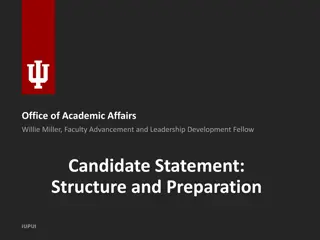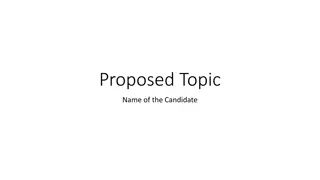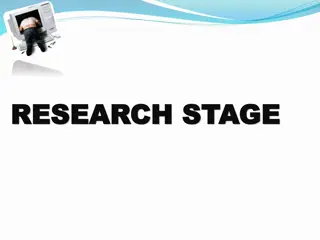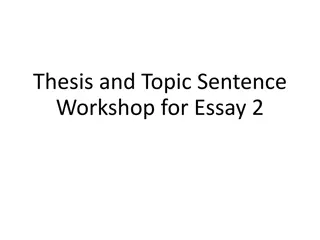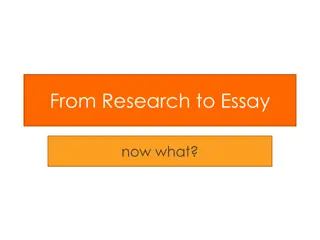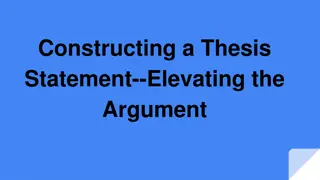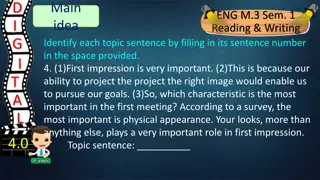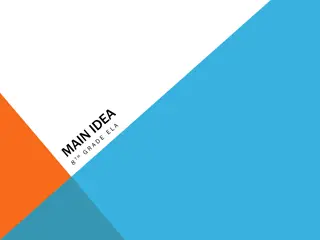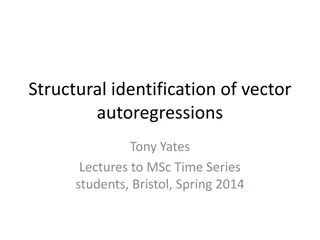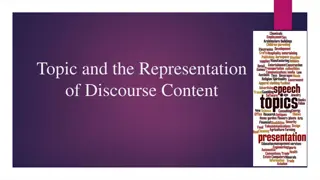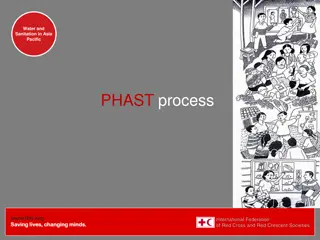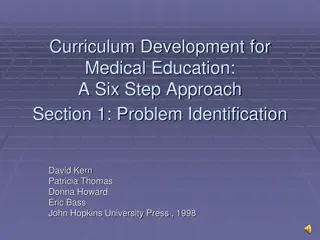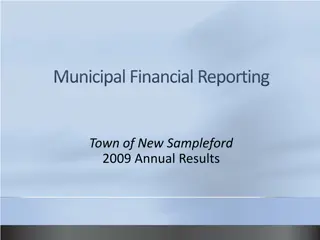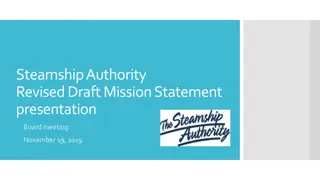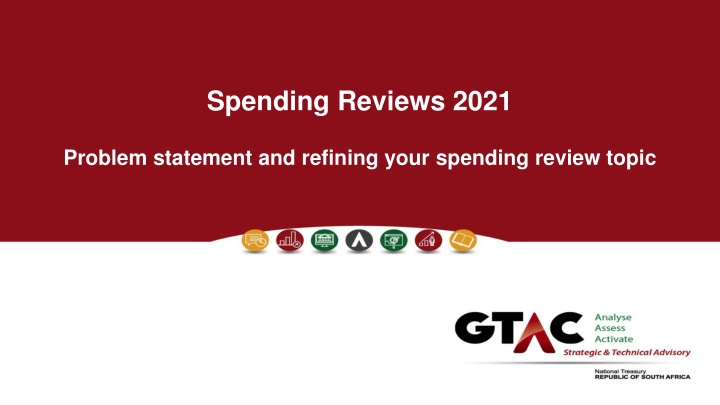
Refining Your Spending Review Topic in 2021
"Learn about the methodology for conducting spending reviews in 2021, including problem statements, institutional analysis, and cost modeling. Understand the objectives and benefits of spending reviews and how they can help identify savings and efficiency gains."
Download Presentation

Please find below an Image/Link to download the presentation.
The content on the website is provided AS IS for your information and personal use only. It may not be sold, licensed, or shared on other websites without obtaining consent from the author. If you encounter any issues during the download, it is possible that the publisher has removed the file from their server.
You are allowed to download the files provided on this website for personal or commercial use, subject to the condition that they are used lawfully. All files are the property of their respective owners.
The content on the website is provided AS IS for your information and personal use only. It may not be sold, licensed, or shared on other websites without obtaining consent from the author.
E N D
Presentation Transcript
Spending Reviews 2021 Problem statement and refining your spending review topic
Spending review methodology What to expect, how will we work? Introduction & Savings Intro Problem statement and institutional analysis What is this delivery programme about? Step 1 Iteration between steps How does the programme work? Process maps and the programme s logical framework Step 2 How is it measured and how should it be measured? Performance analysis and indicators Step 3 What are we spending on the programme? Expenditure analysis Step 4 What does it actually cost to deliver the programme? Cost modelling Step 5 Where and how do we find savings and efficiency gains? Savings and efficiency gains Step 6
Learning outcomes By the end of this session, you should be able to: Identify a topic for your spending review Evaluate the extent to which your topic is suited for a spending review Develop your problem statement 3
Objectives of spending reviews In the current context of rising debt levels, spending reviews represent an opportunity. They have the potential to detect efficiency savings and opportunities for cutting low-priority or ineffective expenditure, and can therefore help achieve smart fiscal consolidation and free up space for new policy priorities, e.g. for additional public investment OECD, 2019 5
What are spending reviews typically used for? Evidence from the OECD To estimate the impact of changes in a policy or a new policy on government spending To scrutinise baseline expenditures - How much public funding will be needed for the new policy? How does varying the policy parameters impact on public spending? - - - - How much money is being spent? On what are we spending public money? Where are spending public resources? Who is doing the spending within government? - Helps to identify savings, contributes to better decisions around reprioritisation, informs decisions about cutting low priority expenditure. Helps policy makers to make decisions about the affordability of new policy or changes. Supports decisions around the implementation of policy. 6
To identify a topic for your spending review, you need to answer a few questions upfront... What is the problem that government is trying to resolve through this programme or institution(s)? Why is it important to examine this particular topic (at this time)? Who will use the findings and reccomendations from the spending review? What data or information do you need for the spending review? 8
Why does government intervene? What problems are governments trying to solve? Social objectives Economic objectives Environmental objectives Promoting fair competition Preserving the environment Redistributing income and wealth Mitigating against the impact of climate change Providing public goods Promoting economic growth Supporting the low-income & vulnerable groups Achieving macroeconomic goals Changing consumer/citizen behaviour Protecting people 10
Why identify the problem statement upfront? The spending review needs a problem statement that defines what government is trying to do/achieve with some set of activities. In all likelihood, you have chosen to focus on that particular set of activities because you know that there is room for improvement in the quality/impact of spending. 11
Problem statement Grand problems have multiple and complex dimensions. Govt. Prog Govt. Prog Pocket problem Pocket problem Grand Problem Pocket problem Pocket problem Govt. Prog Govt. Prog 12
Problem statements Spending reviews focus on the types of pocket problems to which government programmes are designed to respond. Industrial Development Zones, EMIA Tourism incentive programme Barriers to exporting Priority sector support Slow economic growth Lack of support to emerging farmers Competitiveness of local firms Micro Agricultural Funding Institution of South Africa, Emerging Farmer Support programme Clothing and Textile Competitiveness programme 13
The Problem Statement Puzzle In each of your breakout rooms, pick a programme within the Western Cape province. Identify the pocket problem that the programme is trying to resolve. Tell us what you think the grand problem to which your pocket problem is linked. Pick someone to report back! 14
Example from basic education Grand problems Pocket problems Although educational outcomes have improved since democracy, South African children still lag behind their peers from upper middle income developing countries when it comes to academic performance. There are many reasons that explain the performance of the education system: historical inequities between schools, poor quality of teaching, lack of LTSM, limited parental involvement in schooling etc. The inadequacy of teacher support and development is manifested in knowledge gaps observed in many teachers when it comes to subject (disciplinary), curriculum and pedagogical content knowledge In Service Teacher Training programme 15
How to use a problem statement in your spending review? Government programme Spending review objective Problem statement Small and emerging farmers do have the financial resources to buy agricultural inputs and equipment. Moreover, the lack of access to affordable finance was a binding constraint on the ability of small farmers to expand the scale of production. MAFISA was established to provide loans at affordable interest rates to farmers through established financial intermediaries. Through the MAFISA programme, the intermediates procured inputs on behalf of the farmers. To evaluate MAFISA s success in reaching small and emerging farmers and achieve government s objective of expanding agricultural production in an efficient and cost-effective way. 16
Cost-effectiveness of the MAFISA programme Efficiency of the MAFISA model 17
How to identify your pocket problem? When does it occur? What is the problem? Pocket problem (4 Ws) Where is it happening? Who does it affect? 18
Why is it important to examine this topic in a SR? If spending reviews are to be valuable budgeting tools, then they must meet address a specific decision-making need within a department or province. What do you want to achieve with this spending review? Why are you looking at this particular programme? Does the programme have a history of over or underspending? Is it a national or provincial priority or game-changer? 20
Who will use the findings? Effective spending reviews are planned and executed in a way that enhances the likely utilisation of findings to inform decisions. To do this, officials involved in spending reviews should: Identify the primary intended users of the spending review and involve them throughout the process. Keep in mind the audience and primary intended users when writing the report. Collaborate with key stakeholders that findings are discussed, validated and credible. 21
SR methodology Policy, legislation and programme information Decisions Expenditure data (BAS, PERSAL, LOGIS, Management Accounts) Senior officials and political principals Evidence Analyse Performance and administrative information/data Authoritative capacity + willingness 23
Information and data What information do you need to understand the programme? What expenditure data do you need? What administrative and performance information will you require for this spending review? Where and from who are you going to get your data and information? 24
GTAC Government Technical Advisory Centre Private Bag X115 Pretoria 0001 GTAC Government Technical Advisory Centre 240 Madiba Street Pretoria 0002 info@gtac.gov.za www.gtac.gov.za 25

